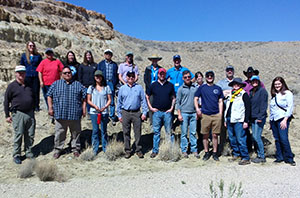Waste & Response:



CERCLA/Superfund
ITEP's Superfund Trainings and Site Visits
Back to Superfund
The Tribal Superfund Working Group has a site visit each year. Details and documents about these site visits are found here.
2019:
Oct
8
Description: This three day training will be the second Tribal Superfund Site Visit offered in 2019 and will include two days of site visits, allowing us to visit four different sites. This training will be taking place in Michigan in cooperation with the Little Traverse Bay Band of Odawa Indians. These are very unique and interesting sites, (such as a decommissioned nuclear reactor and an industrial site converted to housing), and will include discussions about groundwater protection, cultural and habitat preservation, and redevelopment challenges. Other topics will include: an overview of the Little Traverse Bay Bands of Odawa Indians given by the Cultural Department, an overview of Superfund and Brownfields Projects conducted by Little Traverse Bay Bands of Odawa Indians, a Tribal case study of plumes and vapor Intrusion, and a TSFWG Roundtable. If you are interested in applying for this course please submit the following application to ITEP via email or fax.
Register:
MS Word Application
Apr
2
Description: This three day training will include two days in the classroom and a full day field trip. The classroom training will include a variety of topics related to the contamination on the Navajo Nation including: An overview of how the CERCLA Process has been applied on the Navajo Nation, Diné Fundamental Law and TEK, Utilizing Geospatial Technology at Navajo Superfund Program (NSP), How NSP Conducts Outreach on Abandoned Uranium Mine (AUM) Projects, Community Impacts/Engagement in the Cameron area (given by the Cameron Chapter Secretary), Upcoming Disposal Options for AUM’s on the Navajo Nation, Removal Site Evaluation on Boyd Tsi: Technical Presentation on Remediation, and a TSFWG Roundtable. This training will also include an all day site visit to the Cameron area of the Navajo Nation. Anyone from the TSFWG can attend this training and site visit, but your 40 hour HAZWOPER must be current to fully participate in the site visit portion of this trip.
Register:
MS Word Application
2018:
Aug
13
Description: This full day field trip is scheduled for Monday during the Tribal Lands and Environment Forum. The Bunker Hill site was first added to the NPL in 1983. The Site includes mining-contaminated areas in the Coeur d’Alene River corridor, adjacent floodplains, downstream water bodies, tributaries, and fill areas, as well as the 21-square-mile Bunker Hill "Box" where historical ore-processing and smelting operations occurred. The tour encompassed many stops including: Canyon Creek, Hercules Mine and Mill Site, Big Creek Repository and Sunshine Mine, the Central Treatment Plant, the Central Impound Area, the Trail of the Coeur d’Alenes (Rails to Trails). To register for this field trip please contact Todd Barnell (Todd.Barnell@nau.edu) or Julie Jurkowski (Julie.Jurkowski@nau.edu).
Apr
24
Description: This three day training will include two days in the classroom and a full day field trip. The classroom training will include topic such as: approaches to risk assessment, Natural Resource Damage Assessment Restoration, and how different tools and models can be tailored to your community and situation. This training will feature a variety of presentations, and discussion focused on the involvement process. Multiple presenters will discuss the government to government consultation process, developing MOUs, building bridges and working effectively with research institutions, educating and fully engaging community members about potential hazards and what they can do to help protect their communities and the environment. Tribal staff are also putting together a great itinerary for the all-day site visit at the Jackpile-Paguate Mine Superfund.

Agenda [pdf]
2017:
Apr
18
Description: This three day training will include two days in the classroom and a full day field trip. The classroom training will include topic such as: how to develop and use tribal cleanup standards, building tribal capacity to conduct cleanup activities, addressing land use issues, future activities at Tar Creek, a question and answer session with staff from the Quapaw Tribe, a presentation from Cherokee Nation, and a roundtable discussion with other members of the Tribal Superfund Working Group. Tribal staff are also putting together a great itinerary for the all-day site visit which will include remedial and restoration projects and sites of concern. This course will begin at 8:00 am Tuesday and end at 5:00 pm on Thursday. The application can be found below and is due on Wednesday, February 15, 2017.
Application: Tar Creek Superfund Site Visit [doc]
2016:
Aug
15
Description: This full day field trip is scheduled for Monday during the Tribal Lands and Environment Forum. The 18,000-acre New Bedford site is an urban tidal estuary with sediments which are highly contaminated with polychlorinated biphenyls (PCBs) and heavy metals. At least two manufacturers in the area used PCBs while producing electric devices from 1940 to the late 1970s, when the manufacture of PCBs was banned by the EPA. These facilities discharged industrial wastes containing PCBs directly into the harbor and indirectly through the city sewer system. As a result, the harbor is contaminated in varying degrees for at least 6 miles from the upper Acushnet River into Buzzards Bay. Over 100,000 people live within 3 miles of the site. To register for this field trip please contact Todd Barnell (Todd.Barnell@nau.edu) or Julie Jurkowski (Julie.Jurkowski@nau.edu).
Agenda [pdf]
Community Involvement Plan [pdf]
Photos:
Image 1 [jpg]
Image 2 [jpg]
Image 3 [jpg]
May
24
Description: This special opportunity included a day and a half of classroom training in Spokane, Washington as well as a full day site visit to the Bunker Hill Superfund site, led by USEPA and staff from the Coeur d’Alene Tribe. The Bunker Hill site was first added to the NPL in 1983. The Site includes mining-contaminated areas in the Coeur d’Alene River corridor, adjacent floodplains, downstream water bodies, tributaries, and fill areas, as well as the 21-square-mile Bunker Hill "Box" where historical ore-processing and smelting operations occurred. The tour encompassed many stops including: Ninemile Creek, the Central Treatment Plant, the Trail of the Coeur d’Alenes (Rails to Trails), the Black Lake Boat Launches, and Schelepp Agricultural Wetland.
Handouts:
May TSFWG Tour Map [pdf]
Bunker Hill Superfund Case Study [pdf]
Remembering the Giants, Shoshone News-Press Article [pdf]
2015:
Aug
1
Description: This half day field trip took place on August 20, 2015. For many years this site was used for coal tar distillation and wood preservation, which led to contamination of multiple aquifers. This tour included a visit to two large groundwater treatment plants and reclaimed land that now has a community park, soccer fields, and both residential and commercial buildings. The Public Works Superintendent and a field technician discussed the process the City of St. Louis Park went through to tackle regulatory hurdles, the steps they took to remediate the site, and the struggles and successes of the overall project.
Handouts:
Reilly Tar and Chemical Corp. Superfund Site On Site Handout [pdf]
For more information please contact:

